7. Future of Spirulina
Understanding the role of microscopic algae, the foundation of life, can help us develop restorative models of personal and planetary health. Algae is an essential part of Earth’s self-regulating life support system. Innovative schemes and dreams using algae promise to help regreen the desert, refertilize depleted soils, farm the oceans and encourage biodiversity. Coming soon is a significant lowering of production costs, leading to a wide variety of algae products.
Big investments in algae biofuel will grow our future food and its own bio-packaging
Algae Food and its own bio-packaging.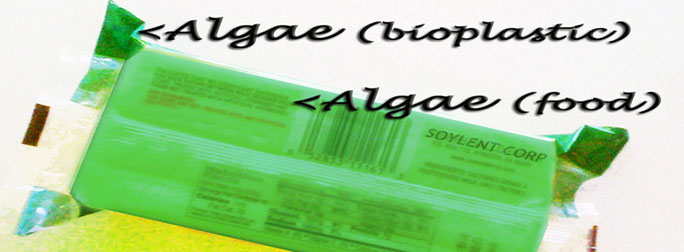
Today, algae has been called the ‘biofuel of the future.’ Over 30 years ago, spirulina algae was called the ‘food of the future’. But until now, production costs have remained high due to a combination of these factors: using agricultural land, fresh water, clean nutrients, skilled personnel, servicing big investments for pond systems, harvesting and drying infrastructure, and complying with food and quality regulations.
With production costs over $10 per kilo, growing algae is still ten times the cost of many commercial foods and feeds. Annual world microalgae output may have reached 10,000 tons of spirulina, chlorella, dunaliella and hematoccocus. Even big commercial algae farms are relatively small, less than 100 hectares in size.
Nevertheless, the number and variety of high value food and specialty products from algae has flourished. Today, algae is an ingredient in thousands of products for food, feed, colors, nutraceuticals, medicinals, cosmetics and personal care, biofertilizers and fine chemicals.
Algae are in more products today than you know.
The shakeout in algae biofuels is good for the algae industry
Algae ventures have successfully raised millions for research and development for algae biofuels based on early promises. To deliver competitive algae biofuel, companies will need to crush costs lower than $1/kg! Will they be able to deliver algae biofuels, within this decade, that are cost competitive with conventional fuels?
So far algae biofuels have been an engaging and expensive R&D project. The challenge of scaling up to demonstration projects begins now. Funding required for demonstration scale up is huge, and the lack of access to funding will amplify the shakeout.
Watch these pathways unfold in the shakeout as the algae industry moves toward more realistic, sustainable business models.
• Those ventures with access to deep financial backing from big oil or government funds, and with technology that works, will be prepared to stay the course and produce biofuel products.
• Some high profile ventures are already repositioning their business model to develop more valuable and more immediate ‘co-products’ from algae. Two years ago, many ventures had dismissed co-product markets for algae food and feed products as ‘niche’ markets.
• Other ventures who realize they can’t make it all the way to biofuel commercialization will license or sell off assets such as algae research, cultivation knowhow, intellectual property, technology or system design or components.
• Some big venture partners will bail. The executive decision will be: “had a good look, got some good green press, but now we are cutting our losses and moving on to more immediately profitable opportunities.”
• Other ventures will continue with smoke and mirrors, touting their secret sauce, proprietary IP or GMO breakthrough to keep grabbing R&D funds or government grants. They operate on the hope that they can sell out to bigger fish before the world perceives they have no clothes.
• More ventures will shut down. Surviving ventures will pick off infrastructure, technology and personnel, like carrion birds feasting on a carcass.
The scramble intensifies for algae ventures to show how their business model can actually produce algae at a reasonable cost for markets that are real and immediate. Many smart algae biofuel companies will be redirecting their finite financial resources toward more immediate income streams from algae products if they are to survive in the shakeout.
Big investments in algae biofuels are bringing big benefits. Breakthroughs from understanding algae cultivation and new technology and systems innovation will dramatically lower algae production costs and open new markets for higher value algae food and feed products. We are entering a very exciting time for algae business development.
Algae food and bio-plastic products are likely to arrive before fuel, one of the least valuable end products. We’ll see healthy algae omega 3 oils and protein food and feed products, improving our diets, and algae based resins, biopolymers and bioplastics replacing fossil fuel chemical products.
How will algae production costs come down?
Innovations and breakthroughs will change the way algae has been produced for 30 years. How? Largely through biomimicry- better understanding how nature works.
• Discover better performing algae cultures. With big R&D budgets, scientists can screen, identify and engineer strains of algae with superior properties, faster growth rates, and ability to grow in low light and temperature and high saline, brackish or ocean water.
• Develop simpler design and technology. Rethink, redesign and reengineer growing, harvesting, processing and drying to reduce capital costs for equipment, operating costs and power use.
• Use marginal land and water just like nature. To grow on the large scale needed to produce biofuels, find remnant flat land and ocean, saline, brackish or waste water located near nutrient resources.
• Use waste nutrients just like nature. To lower costs, recycle waste CO2 effluent, animal and plant wastes, which are costly problems today. Ferment agricultural, animal, industrial and waste streams into carbon, nitrogen, phosphorus, potassium and trace nutrients to feed the algae. Or grow algae by cleaning up municipal waste.
• Use all the algae biomass just like nature. Start with the end product and work backwards. What products can be sold, for how much, and how will markets be developed for those products?
• Create multiple revenue streams to offset costs. Environmental services may include CO2 and pollution mitigation, wastewater treatment, biomass and waste heat for electricity and carbon offsets. Non-fuel algae products may represent the 70% of the biomass. Potential revenues include algae oil and lipid supplementation for animal feedstocks, biofertilizers, fine chemicals and bio-plastics, extracts for pigments nutraceuticals, pharmaceuticals and medicinals.
• Exploit the unexpected- carpe diem. Investment drives innovation and creates breakthroughs. Who knows what will unfold that we haven’t thought of yet.
Adapting spirulina for more growing conditions and applications
A dazzling array of new products are coming from algae. Spirulina will lead the way. Why? Spirulina has four advantages over other microalgae: 1. Proven safe. 2. Easy to grow. 3. Easy to harvest. 4. Ongoing scientific research on health and medical benefits.
The scientific documentation of health and medical benefits will keep spirulina among the most popular algae. For humans, new breaking research this year shows spirulina enhances immune functions for people over 50 years old. For animals and fish, USDA will soon be releasing new data on the value of spirulina.
Spirulina, like other blue-green algae, lends well to adaptation and hybridization, even without resorting to genetic modification. Developing cold weather tolerant spirulina strains will both expand the length of the growing season and the geographic range to more temperate and colder regions. Salt tolerant spirulina will allow the use of abundant salt or seawater. Spirulina adapted to produce a high lipid content such as DHA or EPA could be a valuable Omega 3 source for humans, animals and fish.
Farming alkaline lakes and greening desert coastlines
Spirulina lakes are found in Peru, Chile, Myanmar, Australia and stretch across the Sahara and East Africa, near millions of undernourished people. For 20 years, scientists and visionaries have proposed harvesting algae from lakes in Ethiopia and Kenya.
The best approach is using cultivation ponds beside these lakes, without disturbing the larger ecosystem and the flamingos of the African lakes. They are a tourist attraction, contribute to lake ecology, and should be protected. A project sponsored by governments, international agencies and business could distribute algae to local people. Farming East African lakes could create opportunity as a new food for Africa, relieving pressure on food growing areas, and providing an export crop
Once scientists learn to successfully cultivate seawater tolerant spirulina, new food growing areas can use 10,000 miles of accessible desert coastline in hot climates: Mexico, Peru, Chile, West, North and East Africa, Egypt, Arabian peninsula and India.
Spirulina has big resources advantages over conventional food and meat production. Land and water needed to produce spirulina protein is much less.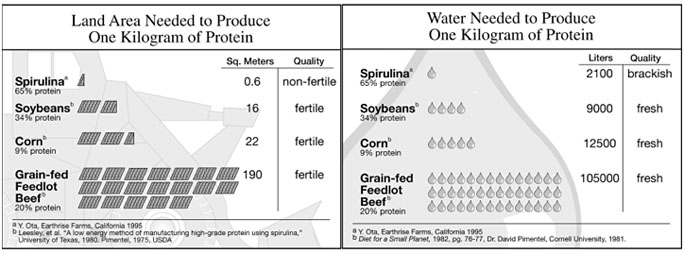
Conventional food production hides environmental costs and consumes natural resources. We pay for these externalized costs, but not at the cash register. Spirulina has few hidden environmental costs and offers more nutrition per acre than any other food. It conserves land and soil and uses water and energy more efficiently per kilo of protein than other foods. As global algae pro¬duction expands using non-fertile land and brackish water, more cropland can be returned to forest and we can regreen our planet.
Microfarms for family and community cultivation
Over the past 30 years, many people have asked they can grow spirulina themselves in their own back yard. In France there are about 50 spirulina microfarmers and a school curriculum for growing algae. Growers are producing their own products and selling directly in the local region.
French microfarms: Spirulina de Savoie and Spirulina de Provence.
Soon, remote sensing devices and cell phone apps will assist the basic functions of culture health monitoring and diagnosis. Growing food in cities and urban areas may become critical as fuel costs rise, making transported food increasingly expensive. On a small land area, a community could meet a portion of its food requirements from microalgae, freeing cropland for community recreation or reforestation.
Unlike plans for algae biofuel that envision mega farms, spirulina can be produced on a small scale. New technologies and systems design will make microfarming less costly, easier and more accessible for even more people around the world. Ecological communities can combine algae production and aquaculture with organic gardens.
Abundance from sharing knowledge and local algae production
Algae can create a future of abundance by offering affordable, locally produced food and energy for ecological, healthy living. Family or community scale abundance microfarms can enhance the health, nutrition and quality of our future life.
Sufficient knowledge about algae production exists today to support successful cultivation. Unfortunately, much of the best knowledge rests with scientists and entrepreneurs who must sequester their research findings due to intellectual property limitations. The algae industry today is fractured as each company acts to protect intellectual property behind a wall of secrecy. Scientists are prevented by non-disclosure agreements to collaborate with others or share production breakthroughs. Secrecy leaves students, researchers, press and policy makers without the most up-to-date knowledge. This degree of secrecy tends to concentrate rather than expand knowledge, slowing innovation.
The 2011 International Algae Competition (www.algaecompetition.com) was initiated as an open source collaboratory to expand a vision for algae in our future. Its objectives are to encourage and share design ideas and best practices for algae production systems, elevate awareness for algae growing systems in backyards, rooftops, vacant lots, public spaces, villages, and promote a healthy and sustainable future for integrated living communities.

Microalgae, like spirulina, are essential resources for individual and planetary health and restoration. The oldest photosynthetic life form is back. It represents a return to the origins of life.
Adapted from “Spirulina World Food- How this micro algae can transform your health and our planet.” by Robert Henrikson © 2010. Available at Amazon.com.
Why Spirulina? | 1. Original Lifeform | 2. Human Rediscovery | 3. Superfood Nutrition
4. Health Benefits | 5. Cultivation Worldwide | 6. Products and Markets | 7. Future of Spirulina

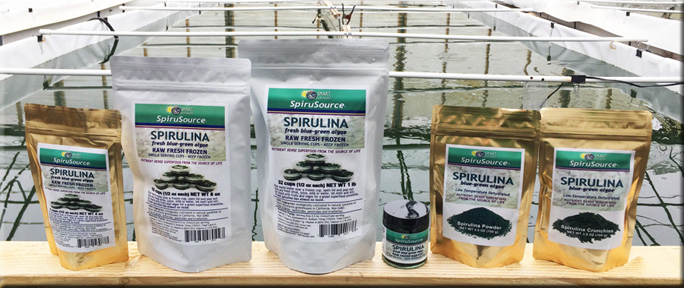
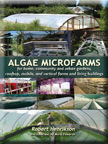
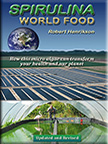 SPIRULINA
SPIRULINA